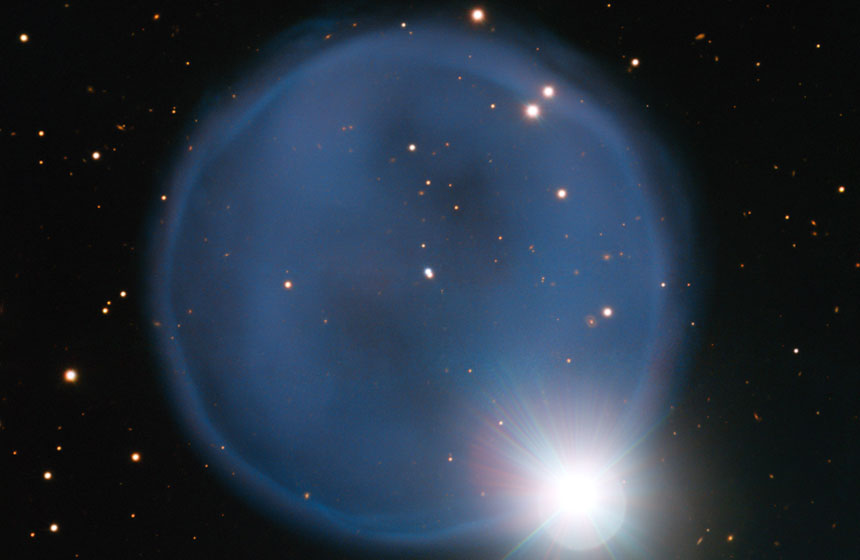A ‘wedding ring’ in space
An unusually circular, ring of gas aligns behind a star to create a sparkling image

The expanding shell of gas shown here, called Abell 33, glows blue. It’s the remnant of a dying star. The bright star that appears to sit on the ring’s edge actually is nowhere near that shell of gas.
ESO
A new image from the Very Large Telescope in Chile shows what resembles a diamond ring in space.
The ring — which appears blue in the image above — is actually the ghostly outer remnant of a dead star. This field of gas, known as Abell 33, is so big that it would take light three years to pass from one side of it to the other.
A star’s glow comes from the fusion of densely packed atoms. Gravity holds this ball of atoms closely together. At the same time, those fusion reactions try to push the ball apart. The star lives in a sort of balance as long as there is enough fuel to keep gravity from making its ball of atoms collapse in on itself. And for the average sun-size star, those fusion reactions may sustain a star in glowing health for some 10 billion years.
But a star won’t live forever. Once most of its fuel has burned up, gravity will allow the star’s denser core to collapse, creating a far denser mix of its heavier elements. When this happens in small to medium-size stars, like our sun, there will be no explosive supernova fireworks. Instead, the star will lose hold of its outer, lighter constituents. Now freed, these gases can begin to slowly drift away as a gently expanding — and glowing — cloud. Astronomers refer to that cloud as a planetary nebula.
And that’s the blue bubble seen here. This nebula resides about 2,500 light-years away in the Hydra constellation.
The denser core of Abell 33’s former star contracted to create a white dwarf, an intensely hot and dense object. Some of the light glowing from it — invisible to the human eye — exists in the ultraviolet part of the electromagnetic spectrum. When this UV light hits oxygen ions in the surrounding planetary nebula, that halo will glow blue (as seen here).
What about the brilliant star in this “diamond-ring setting?” It appears to be perched on the edge of the nebula. It isn’t. That star is only about one-third as far from Earth as the nebula. Only because of a chance alignment do the two appear linked.
Power Words
atom The basic unit of a chemical element. Atoms are made up of a dense nucleus that contains positively charged protons and neutrally charged neutrons. The nucleus is orbited by a cloud of negatively charged electrons.
constellation Patterns formed by prominent stars that lie close to each other in the night sky. Modern astronomers divide the sky into 88 constellations, 12 of which (known as the zodiac) lie along the sun’s path through the sky over the course of a year. Cancri, the original Greek name for the constellation Cancer, is one of those 12 zodiac constellations.
electromagnetic spectrum The range of radiation that spans from gamma- and X-rays through visible light and on to radio waves. Each type of radiation within the spectrum typically is classified by its wavelength.
fusion The merging of two things to form a new combined entity. (in physics) The process of forcing together the nuclei of atoms. This nuclear fusion is the phenomenon that powers the sun and other stars, producing heat and forging the creation of new, larger elements.
gravity The attraction between any two objects with mass. The more mass there is, the more gravity.
light-year The distance light travels in a year, about 9.48 trillion kilometers (almost 6 trillion miles). To get some idea of this length, imagine a rope long enough to wrap around the Earth. It would be a little over 40,000 kilometers (24,900 miles) long. Lay it out straight. Now lay another 236 million more that are the same length, end-to-end, right after the first. The total distance they now span would equal one light-year.
ion An atom or molecule with an electric charge due to the loss or gain of one or more electrons.
planetary nebula A shell of gas ejected from stars like our sun at the end of their lifetimes. This gas continues to expand away from the remaining star (a white dwarf).
star Thebasic building block from which galaxies are made. Stars develop when gravity compacts clouds of gas. When they become dense enough to sustain nuclear-fusion reactions, stars will emit light and sometimes other forms of electromagnetic radiation. The sun is our closest star.
sun The star at the center of Earth’s solar system. It’s an average size star about 26,000 light-years from the center of the Milky Way galaxy.
supernova (plural: supernovae or supernovas) A massive star that suddenly increases greatly in brightness because of a catastrophic explosion that ejects most of its mass.







